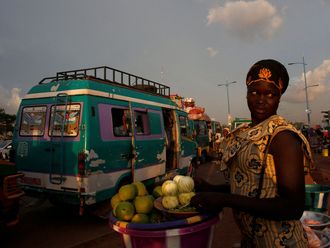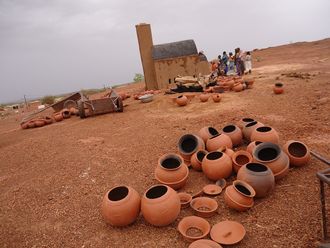The oldest and biggest angiosperm trees in the world, the African baobabs, are dying or already dead, an international team of scientists has found.
The scientists added that the spate of deaths, described in the journal Nature Plants, might be the result of a changing climate — though they say that research needs to be done to confirm or deny that idea.
The baobab known as Adansonia digitata L. is an icon of the African savannah. With wide, cylindrical trunks and gnarled branches, the trees appear to have been yanked out of the ground, flipped over and shoved back in, roots in the air. These giant plants are the largest and longest-living angiosperm (or “flowering”) trees today, with some individuals surviving for close to 2,000 years.
Baobab trees have been nicknamed the “tree of life,” perhaps because their trunks and branches can store large volumes of water in a dry and often unforgiving landscape — stores that both humans and animals have relied on. But they could just as well be called the giving tree: The leaves and fruit of many species also provide nutritious food, their bark can be made into rope and cloth, their wood can be harvested for hunting and fishing tools, and their broad, often hollow trunks can be used for shelter.
But until recently, much about these trees was not known with confidence — which is why in 2005 an international team of researchers embarked on a project to study their structure, growth and age.
Over the years, the scientists have found that big African baobab specimens always have multiple stems. While baobabs typically begin growing as single-stemmed trees, they produce new ones over time, developing increasingly complex structures. These multiple stems can start to trace out a ring-shaped architecture, containing an empty space within.
These structures defy ring-counting, the traditional method of age-dating trees. So the scientists instead used accelerator mass spectrometry to perform radiocarbon dating on samples from the largest, oldest trees in southern Africa.
The researchers found that since 2005 eight of the 13 oldest, and five of the six largest, African baobab trees have either died or had their oldest parts or stems die. This includes Panke, a sacred baobab in Zimbabwe that was estimated to be about 2,450 years old, with a 25.5-metre-wide trunk and a height of 15.5 metres. In 2010, its branches started to fall off; then its multiple stems began to split and topple over; and by 2011 it was dead.
A similar fate befell the Platland tree in South Africa, which the authors call “probably the most promoted and visited African baobab.” Known also as the Sunland baobab, it was the biggest known individual, with a 34.11-metre wide trunk and a height of 18.9 metres. It had lived for an estimated 1,110 years until its largest stem unit split four times in 2016 and 2017 and all five stems fell and died.
“The deaths of the majority of the oldest and largest African baobabs over the past 12 years is an event of an unprecedented magnitude,” the scientists wrote. “These deaths were not caused by an epidemic and there has also been a rapid increase in the apparently natural deaths of many other mature baobabs.”
The scientists did not study what was causing the deaths of these arboreal behemoths, though they pointed to a possible suspect: climate change in the region.
“We suspect that the demise of monumental baobabs may be associated at least in part with significant modifications of climate conditions that affect southern Africa in particular,” the authors wrote. “However, further research is necessary to support or refute this supposition.”












